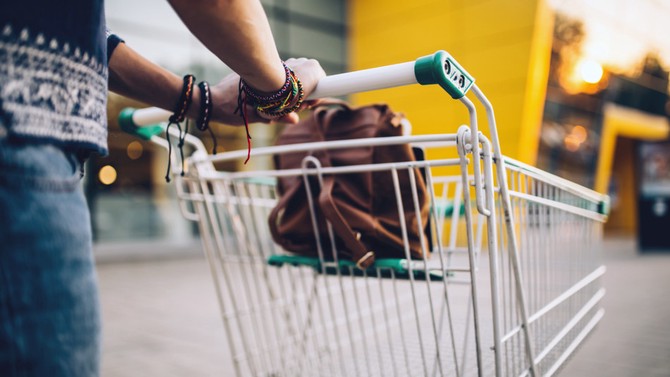6 of the Germiest Places in the Supermarket
You're going to want to bring some wipes.
By Lynn Andriani

Photo: iStock
The Carts
We'll start by confirming your suspicions: There's a good chance your grocery cart (or basket) harbors bacteria. The hard plastic handles of the carts are a "high-contact" area, says Andrew Lai, MD, an infectious disease specialist in Kaiser Permanente Southern California. And on those handles, the microbes that cause, say, the flu virus can survive for up to a few hours. Research has found that the amount of bacteria on some of these carts (on both the handles and in the child seat area, where some people place produce or other foods) is higher even than what's in the average public restroom. There's good news, though: a swipe with an antibacterial wipe kills most harmful bacteria, and many stores now have them available near the cart pick-up area. The important thing, says Lai, is that after you wipe the handle, wait 10 to 15 seconds to let the sanitizer work, and then start pushing the cart. And if your store doesn't have wipes for customer use, BYO.

Photo: iStock
The Checkout
It's one thing to use wipes on the shopping cart—but the store manager may not be thrilled to see you wiping down a conveyor belt at the checkout, or a touch screen at the self-checkout. The thing is, those two spots are pretty germy: PVC belts can harbor yeast, mold, staph and coliforms (and are rarely cleaned, notes Lai); and although touch screens may seem too slick or inhospitable for bacteria to survive, that's not actually the case. Your safest bet is to make sure all produce is in plastic bags before it hits the belt (even if it's just one cucumber), and to wash your hands with hand sanitizer after using a touchscreen, as well as the pen you use to sign if you're paying by credit card, or the keypad where you enter your PIN if you're paying by debit.

Photo: iStock
The Meat Section
The juices from raw meats—a potentially high source of contamination—sometimes seep out of the packaging, so Lai takes extra precautions when handling them. He grabs two plastic produce bags: He uses one as a glove to pick up the package of chicken, beef, pork other meat, and then puts the food into another bag, so any leaking juices don't come in contact with the other foods in his cart.

Photo: iStock
The Free Sample Table
As tempting as those warmed-up squares of frozen pizza look, Lai suggests using discretion. Unless there's someone there handing you the food, preferably wearing gloves, you just don't know if the person before you touched three or four different slices, he says. And if their hands were unclean, it's just not worth the risk.

Photo: iStock
The Salad Bar
Barring random acts of contamination, salad bars and hot food buffets in supermarkets are generally safe, says Lai. The FDA releases a "Food Code" guide every few years, which state and local health authorities typically use to ensure that stores keep foods at the right temperature, avoid cross-contamination and don't leave foods out long enough for bacteria to grow. Still, a 2016 study found that the salad tongs can contain significant levels of E. coli, so be sure to wash your hands after using them.
Photo: iStock
Your Own Bags
Here's one place where you have complete control: your own shopping bags. A small study by the University of Arizona and Loma Linda University (note: funded by the American Chemistry Council, which represents plastic makers), found that almost every reusable bag that consumers were bringing into the store contained large amounts of bacteria (E. Coli was found in 8 percent of the bags). Lai recommends running reusable cloth bags through the normal wash cycle with hot water to kill any dangerous microbes. If your bags are insulated, hand wash or wipe with disinfecting wipes, especially along the seams.
Published 02/26/2018

